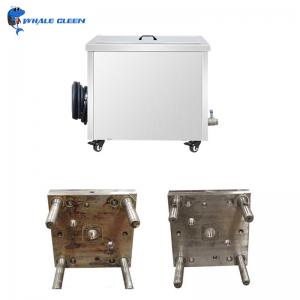
Add to Cart
108L 3KW Heater Industrial Ultrasonic Cleaner For Injection Mold
What Whale Cleen sonic Can Do For You?
The contaminants produced by injection molding operations are tenacious. Examples include flashing, mold release compound, burned-on plastic residues, carbonization and vent outgas residue that if not safely removed will quickly shorten mold life.
The solution is the powerful cavitation action of an ultrasonic cleaner that creates millions of minute bubbles in an ultrasonic cleaning bath comprised of water and a biodegradable ultrasonic cleaner concentrate. When the bubbles contact the surfaces of forms used for injection molding – even the smallest cracks, crevices and blind holes – they violently collapse to strip away contaminants without damaging surfaces. The process can take as little as 10 – 15 minutes although complex molds may require longer periods in the ultrasonic bath. The molds are then rinsed, dried and either stored for future use or put back on line.
Specification:
| Specifications for ultrasonic cleaner z-x30 | |
| Model | Z-X30 |
| Tank capacity | 108L |
| Tank size | 600*450*400mm |
| Unit size | 740*590*620mm |
| Tank material | SUS304 Or SUS316 |
| Ultrasonic power | 1500W |
| Heating power | 3KW |
| Timer | 1-99h adjustable |
| Heater | 0-85c adjustable |
| Frequency | 40khz |
| Control | Inside generator, more stable |
| Optional | Oil filter system, pneumatic lift, rinsing tank, etc. |
| Voltage | 110~140V,200~240V Single phase |
| Warranty | 1 year |
| Packing | 1unit/wooden case |
If this model is not suitable for your cleaning requirement, please contact our sales team for other recommendation.
Cleaning Effect:

The Things You Should Know Before Buying:
The cleaning ability of ultrasonics depends on several key factors:
Mild alkaline solutions also are available that perform well on many residues without the caustic issues. But in general, the friendlier the detergent, the less effective it will be on stubborn contaminants.
Slightly acidic solutions, such as those containing low concentrations of citric acid, excel at rust and oxide removal, but must be used with caution on some tool steels because they can react with the iron in the steel, turning it gray. This normally does not cause a technical problem but doesn’t sit well with toolmakers.
There also are several environmentally safe detergents being used that do a fair job of removing most contaminants left from resins in use today. Combined with a minimal amount of hand scrubbing on heavily contaminated areas, these user-friendly solutions are gaining popularity with companies simply because of their ease of disposal, less mess, and safer working conditions.
The best transducers also are zero-spaced and silver-brazed to the tank rather than bolted or epoxy-glued, because the latter have more tendency to fail slowly over time. Transducers may be placed at specific locations in the tank to correlate with the size and configuration of plates being cleaned.